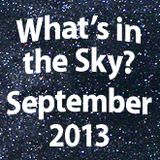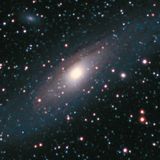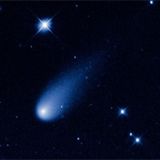
This weekend, September 6-8, 2013, is a prime time to view M34, M27 and the Veil Nebula. Read on to learn how to find them in this weekend's skies.
Friday, September 6 - Today celebrates the founding of the Astronomical and Astrophysical Society of America. Started in 1899, it is now known as the American Astronomical Society. Tonight let's relax a little bit and have a look at a superb open cluster that stays superb no matter if you use small binoculars or a big telescope. Of whom do I speak so highly? M34 (Right Ascension: 2:42.0 - Declination: +42:47...
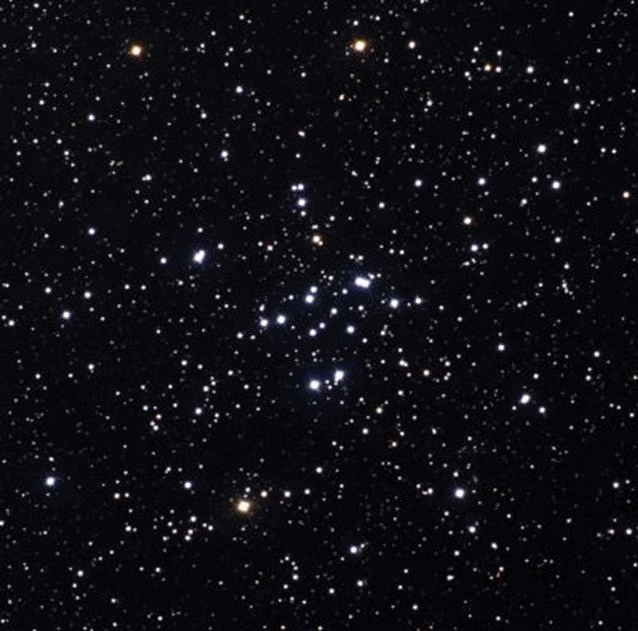
M34 - Credit: REU Program NOAO/AURA/NSF
Easily found on Perseus' west border by scanning between Beta Perseii (Algol) and Gamma Andromeda (Almach), M34 was discovered by Charles Messier in 1764. Containing around 80 members, the central knot of stars is what truly makes it beautiful. At around 1,400 light years away, this stellar collection is believed to be around 10 million years old. While binocular users are going to be very happy with this object, telescope users are going to appreciate the fact that there is a double star right in the heart of M34. This fixed pair is around magnitude 8 and separated by about 20".
Saturday, September 7 - Tonight we are going to take a journey toward an area which has intrigued this author since I first laid eyes on it with a telescope. Some think it difficult to find, but there is a very simple trick. Look for the primary stars of Sagitta just to the west of bright Albireo. Make note of the distance between the two brightest and look exactly that distance north of the "tip of the arrow" and you'll find M27 (Right Ascension: 19:59.6 - Declination: +22:43).
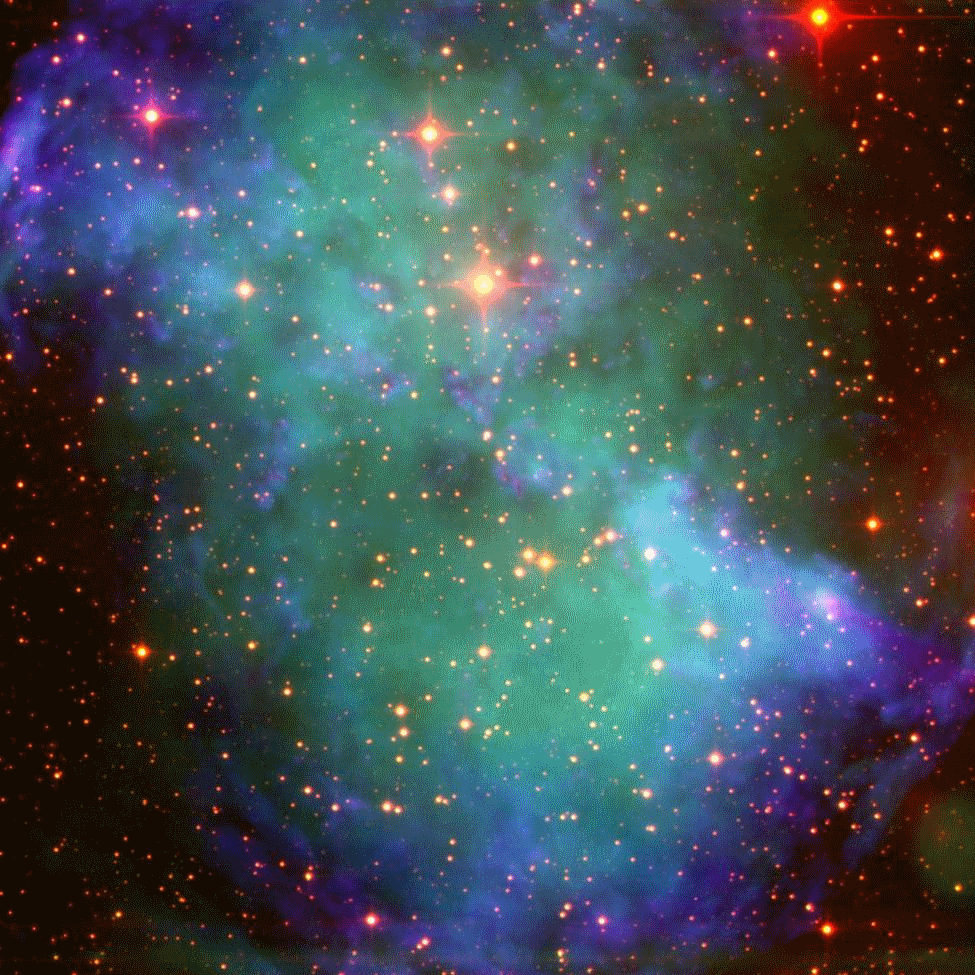
M27 - Credit: Nigel Sharp, Rich Reed, Dave Dryden, Dave Mills, Doug Williams, Charles Corson, Roger Lynds and Arjun Dey /NOAO/WIYN/NSF
Discovered in 1764 by Charles Messier in a 3.5" aperture telescope, I discovered this 48,000 year old planetary nebula for the first time in a 4.5" telescope. I was hooked immediately. Here before my eager eyes was a glowing green "apple core" which had a quality about it that I did not understand. It somehow moved? It pulsated. It appeared "living."
For many years I struggled to understand the 850 light-year distant M27, but no one could answer my questions. I researched and learned it glowed with the light of doubly ionized oxygen. I had hoped that perhaps there was a spectral reason to what I viewed season after season - but still no answer. Like all amateurs, I became the victim of "aperture fever" and I continued to study M27 with a 12.5" telescope, never realizing the answer was right there - I just hadn't powered up enough.
Several years later while studying at the Observatory, I was viewing through a friend's identical 12.5" telescope and as chance would have it, he was using about twice the magnification that I normally used on the "Dumbbell." Imagine my total astonishment as I realized for the very first time that the faint central star had an even fainter companion that made it seem to wink! At smaller apertures or low power, this was not revealed. Still, the eye could "see" a movement within the nebula - the central, radiating star and its companion.
Do not sell the "Dumbbell" short. It can be seen as a small, unresolved area in common binoculars, easily picked out with larger binoculars as an irregular planetary nebula, and turns astounding with even the smallest of telescopes. In the words of Robert Burnham, Jr., "The observer who spends a few moments in quiet contemplation of this nebula will be made aware of direct contact with cosmic things; even the radiation reaching us from the celestial depths is of a type unknown on Earth..."
Sunday, September 8 - Today in 1966, a legend was born as the television program Star Trek premiered. Created by Gene Roddenberry, its enduring legacy inspired several generations to an interest in space, astronomy, and technology. Its five-year mission still airs - along with numerous movie and series sequels. May Star Trek continue to "live long and prosper!"
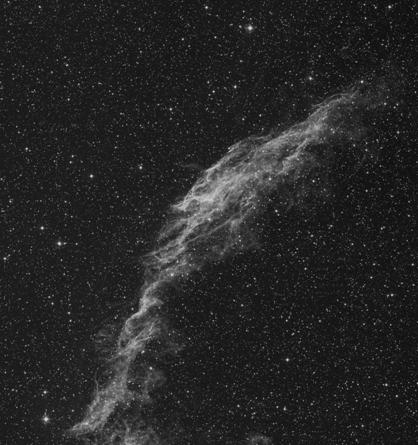
NGC 6992 - Palomar Observatory, courtesy of Caltech
Tonight is a great opportunity to have another look at all the things we've studied this weekend. However, I would encourage those of you with larger binoculars and telescopes to head for a dark sky location, because we are going on a quest... The quest for the holy "Veil".
By no means is the Veil Nebula Complex an easy target to observe. The brightest portion, NGC 6992 (Right Ascension: 20:56.4 - Declination: +31:43), can be spotted in large binoculars and you can find it just slightly south of a central point between Epsilon and Zeta Cygnii. NGC 6992 is much better in a 6-8" scope however, and low power is essential to see the long ghostly filaments which span more than a degree of sky. About two and a half degrees west/southwest, and incorporating star 52 Cygnii is another long narrow ribbon of what may be classified as a supernova remnant. When aperture reaches the 12" range, so does the true breadth of this fascinating complex. It is possible to trace these long filaments across several fields of view. They sometimes dim and at other times widen, but like a surreal solar flare, you will not be able to tear your eyes away from this area. Another undesignated area lies between the two NGCs, and the whole 1,500 light year distant area spans over two and a half degrees. Sometimes known as the "Cygnus Loop", it's definitely one of the summer's finest objects.
Until next week? Enjoy...
Tammy is a professional astronomy author, President Emeritus of Warren Rupp Observatory and retired Astronomical League Executive Secretary. She has received a vast number of astronomy achievement and observing awards, including the Great Lakes Astronomy Achievement Award, RG Wright Service Award and the first woman astronomer to achieve Comet Hunter's Gold Status.


